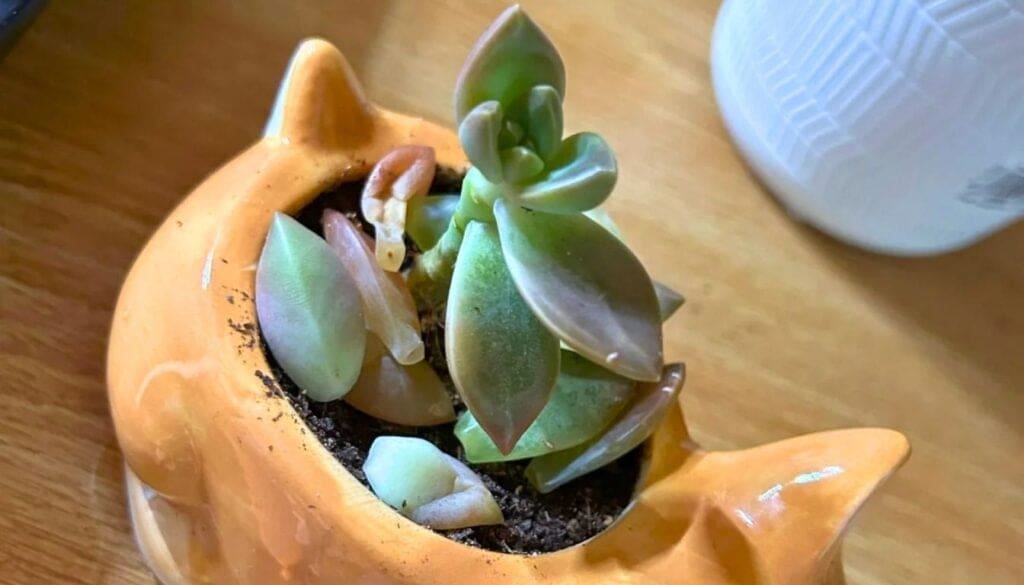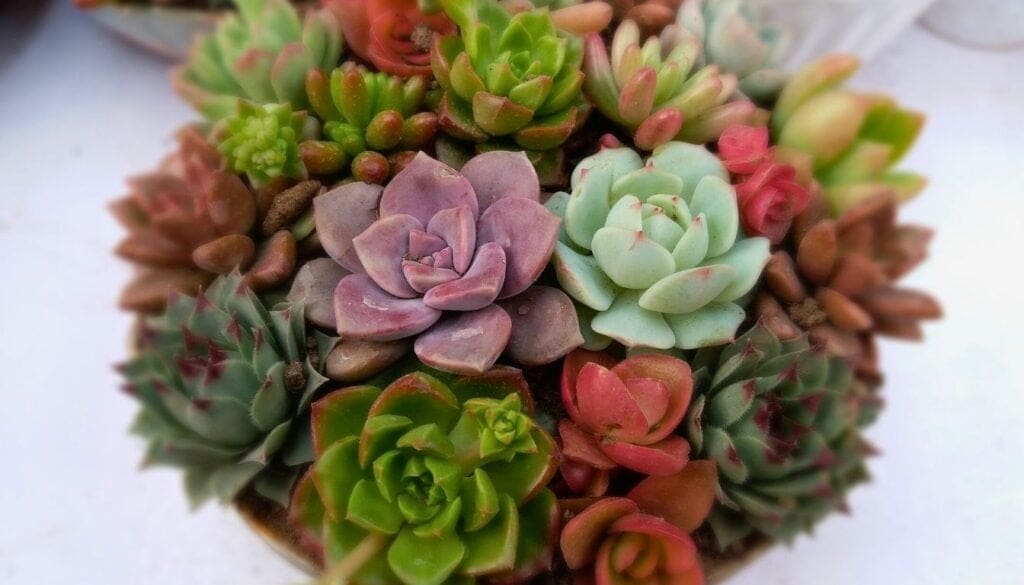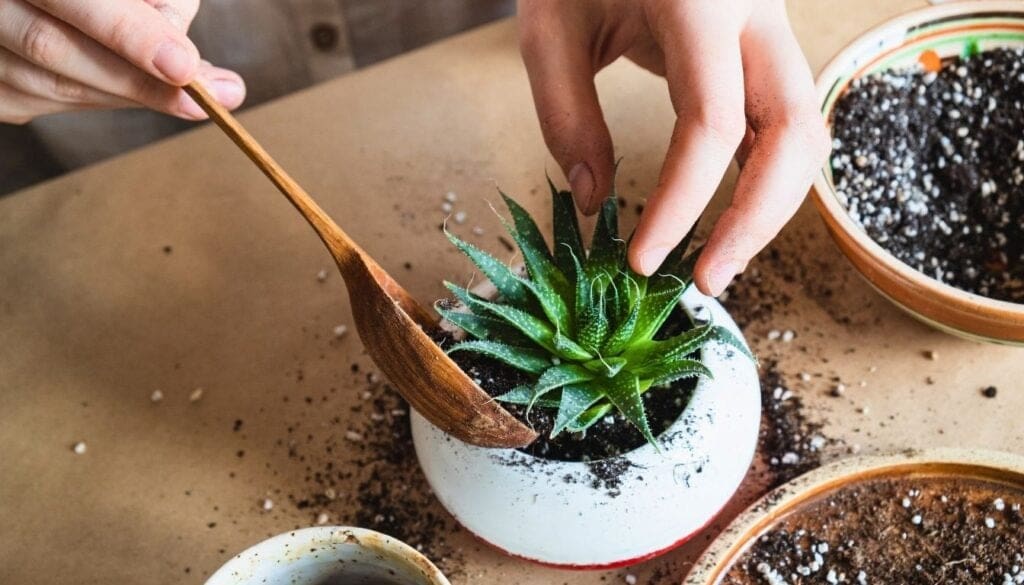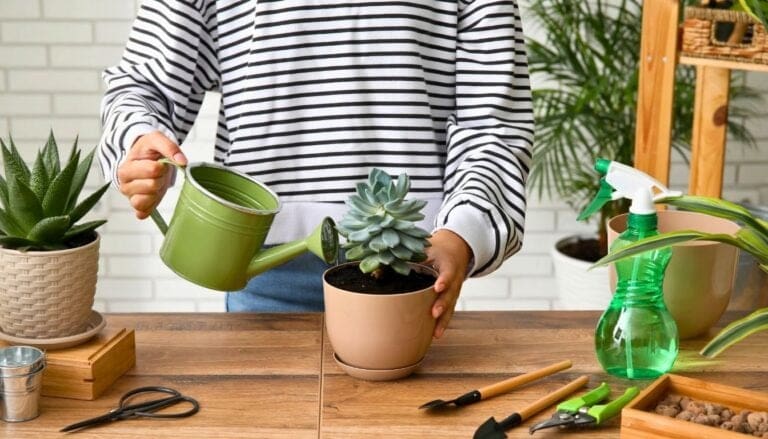7 Reasons Your Succulents are Dying: Easy Tips to Revive Them!
Hey plant lovers! Have you ever looked at your succulents and wondered why they seem to be struggling? Sometimes, it feels like these cute little plants just don’t want to thrive. Don’t worry, I’ve been there too!
Getting to know the reasons behind a succulent’s struggle is the first step in bringing them back to life. 🌵
I know how frustrating it can be when your bright, sunny windowsill garden turns a little brown. Are you overwatering? Maybe giving them too much love? 🌞
Let’s dive into the common mistakes and explore some easy ways to revive our leafy buddies!
Feel free to share your own tips and rescue stories in the comments below. 😊

Please note: Simplify Plants is reader-supported. As an Amazon Associate, I earn from qualifying purchases made by our readers with no extra cost added to you all! Some links in the post are affiliate links and I get a commission from purchases made through links in the post.
1) Overwatering your succulents
Oops, did you give your succulents too much love in the form of water? 🌧️ It’s a common mistake! I’ve been there too.
Succulents need much less water than other plants. They store water in their leaves, so extra water can cause them to become mushy and sad. 😢
How can you tell if you’re overwatering?
Take a look at the leaves. If they’re turning yellow or translucent, that’s a red flag.
Do they look swollen? If yes, they’ve probably had enough to drink.
Remember, succulents are like camels—they store water for later!
I find it helpful to check the soil with my finger before watering. If it’s dry a couple of inches deep, then it’s time for a sip.
If it’s still damp, skip the watering can.
It might feel strange at first to water less often, but your plants will thank you!
Have you ever wondered why we overwater? Sometimes we see a droopy plant and our first thought is to give it a drink. But when it comes to succulents, less is more! 😜
When in doubt, wait a few more days.
Share your overwatering stories and any tips you have in the comments below! 😉 Let’s help each other keep our little green friends happy and healthy.

2) Insufficient sunlight: Move to a brighter spot
I’ve been guilty of this one myself 🤦♂️. Your succulents might be sad because they’re not getting enough sunlight. These little green buddies love the sun, and they need plenty of it to stay happy and healthy.
Think about how much sunlight your succulents are getting every day. Are they in a shadowy corner or under some furniture?
Let them bask in more light by placing them near a sunny window, preferably one that faces south if you’re in the northern hemisphere 🌞.
It’s amazing what a bit of extra light can do! Sometimes, just moving them a few feet into a brighter spot can make all the difference.
Keep an eye on them to make sure they’re not getting too much direct sunlight, which can cause burning.
If you don’t have enough natural light, consider using a grow light. These can be a lifesaver in keeping your plants looking fab all year round.
Have you noticed your succulents stretching or leaning? That’s their way of begging for more light.
Give them what they need, and they’ll spring back to life with vibrant colors and strong leaves.
Trust me, your succulents will thank you with their beauty and charm.
Have you ever had to move your plants to a sunnier spot? Let me know in the comments below! 🌿⬇️

3) Poor soil drainage: Use cactus soil mix
Have you ever wondered why your succulents seem sad and droopy? 🤔 Poor soil drainage might be the culprit. If water doesn’t drain well, your succulents could get waterlogged, leading to root rot. Not fun, right?
When I first got into succulents, I had no clue how important soil type was. 😅 I used regular potting soil at first, thinking it would do the trick. Big mistake! My succulents started looking more soggy than snazzy.
Switching to a cactus soil mix changed everything. This mix is designed to let water drain quickly and prevents water from sitting around the roots. It’s like giving your succulents their very own happy, dry home! 🌵
The best part? Cactus soil is easy to find and affordable, too. Having the right soil is like wearing the perfect pair of shoes—it just makes everything better!
Ever notice how succulents thrive in desert-like conditions? By using soil that mimics these conditions, you’re setting them up for success. 🎉
What kind of soil do you use for your plants? Share your thoughts and tips in the comments below! 📝

4) Cold temperature exposure: Keep them warm
Have you ever noticed your succulents looking sad and droopy during the colder months? 🥶
Succulents love warm and cozy environments, much like we do when it’s chilly outside. Cold temperatures can really stress them out.
I like to keep my succulents indoors when it gets cold. It’s like giving them a snug sweater!
Make sure they sit in a sunny spot, away from drafty windows or doors.
Did you know some succulents can get frostbite? ❄️
That’s why it’s important to bring them inside when temperatures drop below freezing. It’s a simple step, but it makes a huge difference.
If your plants must stay outside, try covering them with a light cloth at night. This gives them an extra layer of warmth during those chilly nights.
Remember to check if your heating system dries out the indoor air.
I use a little humidity tray to make sure they stay happy and not too dry! 🌵💧
Your succulents rely on you to keep them warm. A slight shift in temperature can be the difference between thriving plants and those struggling to survive.
How do you keep your succulents warm during winter months? Share in the comments!✨

Pests and bugs: Treat with insecticidal soap
Ever notice tiny bugs on your succulents? These pesky creatures can really harm your plant babies. 🐛
Common culprits like aphids, mealybugs, and spider mites can suck sap from your succulents, making them weak.
One trick I’ve found helpful is using insecticidal soap. It’s safe for most plants and targets those annoying bugs directly. You simply spray it on the parts of your succulents where bugs hang out.
Why insecticidal soap, you ask?
It’s gentle on plants while being tough on bugs! Non-toxic to humans and pets, it won’t leave harmful residues. Plus, it’s pretty easy to find in most garden stores.
Before I spray, I usually test a small area first. That way, I can make sure my succulents don’t have a bad reaction.
If you spot bugs early, you’ll be ahead of the game.
Remember, my trick is just one of the tools you can use. Sometimes a good rinse with water helps knock some pests off too.
Got any other tips to save succulents? I’d love to hear what works for you! Share your ideas below, and let’s help our plants thrive together. 💬🌿
6) Inadequate watering schedule: Adjust frequency

Ever felt like you’re trapped in a cycle of giving too much or too little water to your succulents? I’ve totally been there! 🌵
Let’s fix that together.
Most of us have busy lives, and it’s easy to forget about watering plants. But succulents don’t need water every day. They love a little neglect.
I water mine about once a week when the soil is dry. Too much love (aka water) can make them sad and mushy.
How do you know if you’re doing it right?
Check the leaves! If they look plump and healthy, you’re nailing it. 🎉 If they’re shriveled, it might be time to adjust.
Ever found yourself guessing if your plants need a drink?
Here’s a tip: Stick a finger into the soil.
If it’s dry up to 1 or 2 inches, it’s time to water. Easy, right?
I’ve learned that different seasons mean different needs. In summer, succulents might be thirstier due to the heat. In winter, they might only need a drink once a month. Pay attention to your plant’s signals.
Have you ever talked to your plants? 😊
I like asking mine how they feel. Of course, they don’t answer back, but it’s a fun way to remember to check on them.
What’s your struggle with watering? I’d love to hear! Share your thoughts and tips in the comments. Maybe we can help each other keep our little green friends happy! 💬🌿
7) Lack of airflow: Provide good ventilation
I’ve noticed that poor airflow can really make succulents struggle. They love a fresh breeze just like we do! 🌬️
Without it, they might rot or get moldy. So, open a window or use a small fan. This simple trick can make a big difference.
Imagine wearing a sweater in the middle of summer with no AC on. That’s how your succulent feels with no air around it. 😅
Let your plants breathe by giving them some space. Avoid crowding them too close together on a shelf or a windowsill.
Have you ever smelled that stale air in a closed-up room? No one likes that, and neither do your succulents.
Good circulation helps keep them happy and healthy, plus it’s good for keeping away pests. 😊
Sometimes, it’s easy to think that more light or water is what they need. But think about whether they might just need a nice breeze. Who doesn’t love a gentle wind brushing by?
Is your plant sitting in a spot where the air never moves? Try changing its location. It’s an easy fix that might be just what it needs.
If possible, place them near a window that you can crack open every now and then.
Feel free to share your own tips or challenges with keeping succulents happy in the comments! Your input might just help someone else. ✨💬

Understanding Common Issues
Let’s talk about some common problems that can cause your succulents to struggle. From too much water to not enough light, these issues can quickly lead to unhealthy plants. Don’t worry though, because I’m here to help you spot these problems and get your green friends back to their best.
Root Rot
Have you ever accidentally overwatered your succulents? 🌧️ I know I have!
Root rot happens when succulents sit in water for too long. Their roots get soggy, turn brown, and start to decay. A classic sign is if your plant looks droopy, even though the soil seems wet.
To help your succulents, make sure they’re in a pot with drainage holes. This way, any extra water can easily escape.
It’s important to let the soil dry out between waterings. To test, just stick your finger in the soil. If it feels dry an inch down, it’s time for a drink. If soggy, give it a little break from water.
Pest Infestations
Yes, even succulents get bugs. Are your leaves looking a little chewed up or sticky? It might be pests like mealybugs or spider mites.
These tiny creatures love to feast on your plants and can cause serious damage. 😱
I suggest giving your succulents a close check-up every now and then. If you spot any bugs, you can wipe them off with a cotton swab dipped in rubbing alcohol.
We’ve all had days where we need some TLC, and your succulents are no different! For more stubborn invaders, an insecticidal soap spray can help kick them out.
Insufficient Light
Succulents need plenty of sunlight to thrive. Without enough light, you might notice them stretching out, looking all lanky and pale.
Kind of like me before my morning coffee! 😅
If your succulents are indoors, try placing them near a south or east-facing window where they can soak up those rays.
Outside, make sure they’re in a spot with lots of sunlight.
Feel free to experiment with different spots to find the perfect lighting for your plants.
Got tips of your own? Share them in the comments! 🌿💬
Having healthy, happy succulents makes any space feel alive.
And hey, if you’ve got a funny succulent story, I’d love to hear it! 😊 Let’s keep the conversation going.
Best Practices for Succulent Care

I love taking care of succulents because they’re easy and fun! 🌵
Let’s talk about three things that will keep your succulents happy and healthy.
Get ready for the best tips on watering, soil, and the ideal environment for these cute plants.
Proper Watering Techniques
Did you know that the most common mistake in succulent care is overwatering? I was guilty of that at first!
Succulents need less water than you’d think.
It’s best to water them only when the soil feels dry to the touch.
A good rule is to water them every 1-2 weeks.
Remember, it’s better too dry than too wet for succulents. 💧
One funny thing is to pretend you’re a rain cloud: water thoroughly so it reaches the roots, then step back and let it dry up.
If you see leaves getting mushy, your plant is begging for less water!
Also, try to water the soil directly rather than misting the leaves. This helps prevent mold.
Soil and Pot Selection
Choosing the right soil and pot is like picking out a comfy bed for your succulents. 🛏️
They love a well-draining mix. Regular potting soil might hold too much water, so I like to use a special cactus or succulent mix. You can also add sand or perlite.
The pot choice is just as important! A pot with a drainage hole is a must.
This way, extra water has somewhere to go and your succulents’ roots won’t sit in water, avoiding rot.
Go for a pot that’s the right size for your plant. A big pot might be tempting, but it can lead to too much moisture in the soil.
Ideal Temperature and Humidity
Did you know that succulents are sun lovers? ☀️
They thrive in bright, indirect sunlight. However, direct hot sun can also damage them, so a balance is key.
Inside the house, a sunny window might be perfect. Outside, some shade during peak hours is beneficial.
They’re also not big fans of cold weather or high humidity.
Most succulents prefer temperatures between 60-80°F.
In winter, try to keep them away from drafty windows. As for humidity, they’re desert plants, so a dry environment is best.
Got tips or funny succulent stories of your own? Drop them in the comments! Let’s keep sharing and learning together. 🌱
Advanced Tips for Healthy Succulents
I’ve noticed that growing healthy succulents can sometimes feel like a puzzle.
With a bit of know-how on fertilizing, propagation methods, and disease management, your plants can thrive.
Let’s explore some clever tricks and important insights to help your succulents flourish! 🌵
Fertilizing Succulents

Feeding your succulents is like giving them a tiny energy boost.
I recommend using a balanced, water-soluble fertilizer.
Aim for one that’s diluted to half-strength during the growing season (spring and summer).
Did you know succulents don’t need much? Over-fertilizing can actually harm them! 😮
So, it’s better to feed them lightly.
How often should you fertilize? Try doing it once a month.
Also, keep an eye on the leaves. If they start turning yellow or seem weak, it might be a sign of too much fertilizer.
Remember, less is more with these tough little plants!
Propagation Methods
Want more succulents without spending a dime? Let’s talk propagation!
One popular way is leaf cuttings. Gently twist off a healthy leaf, let it dry for a day or two, then place it on soil. Water sparingly until roots form.
It’s like magic seeing new plants grow from a single leaf! ✨
For faster results, try using stem cuttings. Cut a section of the stem, let it callous over, and plant it in soil. Boom, you’ve got a new plant!
Ever tried water propagation? Place a cutting in a jar with water; watch roots develop!
Identifying and Treating Diseases
Succulents can sometimes get sick.
Have you ever noticed weird white stuff on your plants? That could be mealybugs. These pests love to hide in leaf crevices. I use a cotton swab dipped in rubbing alcohol to get rid of them.
Another troublemaker is root rot. This usually happens when succulents sit in water too long.
If leaves are mushy or falling off, check the roots. They should be firm and white.
If not, remove the rotten parts and let the plant dry before replanting. It’s like giving them a fresh start!
Do you have any other succulent care tips? Share your thoughts and experiences in the comments below! 💬 Happy planting! 🌿
Frequently Asked Questions
Succulents are stylish and trendy, but let’s be honest, they aren’t the easiest to keep alive. 😅
We’ll explore what overwatered succulents look like and why they seem so fragile. Plus, I’ll share how to spot a dying succulent and save it! Let’s dive in!
What does an overwatered succulent look like?
When I’ve overwatered a succulent, it looks mushy. The leaves can turn yellow or translucent and might start to fall off.
It’s like they can’t hold up any longer! Letting the soil dry out is key to reviving it.
Why do succulents die so easily?
I’ve noticed that succulents need just the right balance of water, light, and air.
Too much love, in the form of water, can be their downfall. They also need plenty of sunlight and a warm space.
Ever tried chilling in the dark? That’s how succulents feel without enough sun!
How can I tell if my succulent is dying?
For me, a telltale sign is when leaves start turning brown or black.
If your succulent feels soft and mushy, it’s crying for help. Sometimes, all it needs is a sunnier spot or a change in soil to thrive again.
What are the common signs of a succulent dying from the bottom up?
I find that when succulents start dying from the bottom, the lower leaves become shriveled and crispy.
It’s like they’re shedding their old leaves to focus on the top. Keeping the plant in well-draining soil can help prevent this issue.
What can cause succulent leaves to fall off?
In my experience, leaves may drop due to poor watering—either too much or too little.
Extreme temperature changes or pests can also stress them out. When pests invade, I make sure to treat my plants with insecticidal soap to keep them healthy.
What are some effective tips to revive a dying succulent plant?
I’ve learned that moving my succulent to a spot with more light and checking the soil for drainage issues can work wonders.
Resist the temptation to overwater. If you’re feeling unsure, letting the soil dry out completely before watering again is a safe bet.
So, do you have any succulent tales to share? Comment below! 🌵❤️
Recommended Garden Supplies
| Product Image | Our Recommended Gardening Supplies | Check Offers! |
|---|---|---|
Top Top
Top
Top
Top
Top
Top
Top
Top | rePotme Houseplant and Tropical Classic Potting Soil Mix | Check Offer On Amazon |
 Top
Top
Top
Top
Top
Top
Top
Top | Espoma Organic Indoor Plant Food | Check Offer On Amazon |
 Top
Top
Top
Top
Top
Top
Top
Top | GooingTop LED Grow Light 6000K Full Spectrum Clip Plant Growing Lamp | Check Offer On Amazon |
 Top
Top
Top
Top
Top
Top
Top
Top | Soil Moisture Meter | Check Offer On Amazon |
 Top
Top
Top
Top
Top
Top
Top
Top | Govee Hygrometer Thermometer, Bluetooth Enabled! | Check Offer On Amazon |
 Top
Top | LEVOIT Humidifiers for Large Room(Best For Plants) | Check Offer On Amazon |
 Top
Top
Top
Top
Top
Top
Top
Top | Upgraded DIY Automatic Drip Irrigation Kit, 15 Potted Houseplants Support | Check Offer On Amazon |
 Top
Top
Top
Top
Top
Top
Top
Top | Stainless Steel Heavy Duty Gardening Tool Set | Check Offer On Amazon |
 Top
Top
Top
Top
Top
Top
Top
Top | Bonide Insecticidal Soap | Check Offer On Amazon |
 Top
Top
Top
Top
Top
Top
Top
Top | Bonide 32 oz Spray Neem Oil for Organic Gardening | Check Offer On Amazon |
 Top
Top
Top
Top
Top
Top
Top
Top | Garden Safe Fungicide | Check Offer On Amazon |






